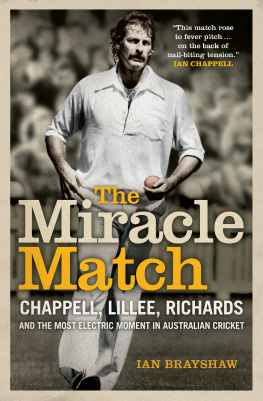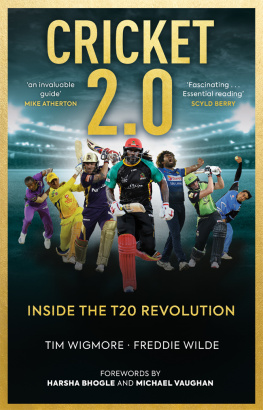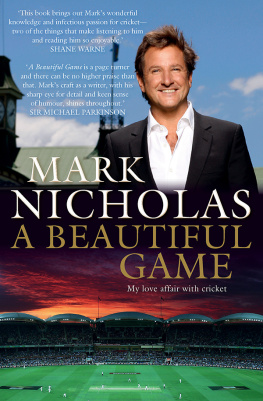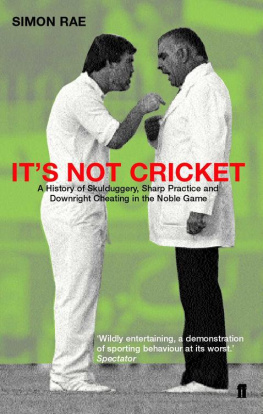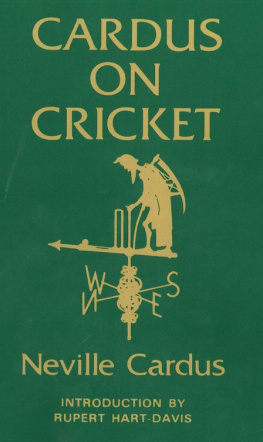HARRY RICKETTS was born in London in 1950 and grew up in England, Malaysia and Hong Kong. After reading English at Oxford University and obtaining a B Litt, he taught at Hong Kong and Leicester Universities, before moving to live in New Zealand in 1981. He is an associate professor in the School of English, Film, Theatre and Media Studies at Victoria University of Wellington. His poems, critical essays and literary reviews have appeared in journals in New Zealand, Australia, Hong Kong, France and the United Kingdom. Playing, watching and reading about cricket have been a central passion since childhood. In a long if never particularly illustrious career, he has played cricket in three continents, taken five hat tricks and scored two centuries.
Cricket: A sport at which contenders drive a ball with sticks or bats in opposition to each other.
Samuel Johnson,
A Dictionary of the English Language
Before the start of play
ITS JUNE 1955. My father and I are playing cricket on our pocket handkerchief of a lawn. Our house is in a barracks just outside Worcester, and the lawn is surrounded by laurel bushes, with spikes on top of the walls behind. My father, an English army officer, is a quiet man with a salt-and-pepper moustache, rather shy. Good shot, he says. Keep your eye on the ball. Hard lines. When its my turn to bowl, I run round and round the garden, whirling my arms and shouting, Im Typhoon Tyson! until I get giddy and fall over giggling.
August 1961. My father and I sit transfixed on blue-backed chairs in the study. On the black-and-white .
Suddenly Dexter flashes at a ball and is shot without covering his wicket with the left pad an elementary mistake.
The next batsman is Brian Close, a left-hander. Within minutes he too has committed cricketing suicide, sweeping. My father and I sit on in the blue-backed chairs, distraught, disbelieving, as almost-victory slides inexorably to defeat.
August 1976. The scorching English summer of Dutch elm disease. I am on holiday from my job in Hong Kong and staying with my friend David in Elvington, just outside York. David has secured us a game for the Elvington Second XI. The game against the staff of a supermarket chain takes place on the edge of a park. The at each end marked out in white. It is a minefield, lethal. The ball either shoots along the ground or knocks your head off.
. The batsman leaves the first two balls, aims to swipe the third and win the game. The ball nips underneath the bat, hits leg-stump. The game is a tie.
January 1984, Wellington. From the garden comes the regular thud, thud of a tennis ball being thrown against a wall and hit back. My stepson Max is practising his batting. Hes a left-hander, so he stands, side-on to the wall, bat in right hand, ball in left. I can picture the scene: his intense concentration as he throws the ball, then quickly grips the bat with both hands and lunges forward as the ball bounces back at him. Hes not a natural sportsman, but by assiduous practice and great effort of will he has made himself a reasonable batsman. His knowledge of contemporary cricketers, both from New Zealand and overseas, is already encyclopaedic. How many did Martin Crowe score on his Test debut? (9 played with me. Max also practises on his own for hours. Thud, thud.
Its now January 1990. My team the one Ive played for since 1982 has a match at Tawa. We have only nine players. This is not good, nor is the fact weve scored only 80-something runs. Ive brought my daughter Jessie (nine) and my second son Jamie (seven) with a picnic to watch the match. They both know how to play from Saturday Kiwi cricket and games at home. Weve batted hopelessly, but Tawa arent strong and we still have a chance.
I ask the kids tentatively whether theyd like to field for us to make up numbers. They seem keen. I ask the Tawa captain if he minds. He doesnt. I tell the kids just to try and stop the ball if it comes near them, but on no account to try and catch it. I position Jessie at both ends, directly behind our wicket-keeper, a young journalist called John Campbell, and Jamie, who is more cricket-savvy, directly behind the bowler. Both make invaluable stops, and thanks to our left-arm spinner, Bede Corry, we win by half a dozen runs.
January 2001. My team (still the same one at fifty, Im now the oldest member) is playing a game at Grenada North. Also in the team are Jamie, now eighteen, and another stepson, Tom. In itself its not a particularly memorable game, but Jamie nonchalantly takes a high catch off Toms bowling. The ball seems to hang in the air forever before coming down. Someone takes a photo of the three of us, in front of slopes of gorse, our eyes screwed up against the sun.
I sometimes ask myself what it is about cricket that has kept me playing and watching it with undiminished passion for half a century. And when I do, I blame my father. It was he who taught me the absolute basics of the game on that tiny lawn when I was five. Showed is probably a better word. Cricket, as he showed it, went more or less like this. The person holding the bat was called the batsman, and stood in front of three sticks in the ground (the wicket) with two smaller sticks across the top (the ). The person with the ball usually my father was called the bowler, and lobbed the ball at the wicket, trying to hit it. As the batsman, my job was to try to prevent the ball hitting the wicket, and, if possible, to whack it as far as I could.
It looked easy, but it wasnt. The ball, usually a tennis ball, would come towards me, fairly slowly. I would watch it all the way. It would bounce. I would swing the bat and often, somehow, miss. If the ball hit the wicket, my father would usually give me another go. He was infinitely patient.
That duel between bowler and batsman is the essence of cricket. The bowler is trying to hit the wicket. The batsman is trying to prevent this, and to hit the ball as far as possible. Everything else in cricket is merely an amplification of this essential encounter.
. Each team takes it in turn to bat and bowl. The object is for one team to score more runs than the other. The object of the team that is fielding is to dismiss, or get out, ten of the batsmen on the opposing team.
All eleven of the bowling side are on the field at once, but only two batsmen; their team-mates sit on the sidelines.
In the middle of the field stand two wickets, 22 yards (20 metres) apart, with white-painted lines to show where the batsmen should stand the batting crease and from behind which the bowler should bowl . One batsman faces the bowler; the other stands at the bowlers end, ready to run if required.


